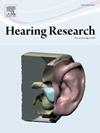快速超听觉筛选和见解从扩展高频听力,语音噪声感知和自然声音评估。
IF 2.5
2区 医学
Q1 AUDIOLOGY & SPEECH-LANGUAGE PATHOLOGY
引用次数: 0
摘要
听觉亢进是一种以声音耐受能力下降为特征的听力障碍。然而,诊断方法仍然存在争议,既要考虑主诉,也要考虑听力损伤的客观测量。本研究旨在提出一种快速筛选方法,使用视觉模拟量表,结合听力评估,以明确涉及这种听力不适的生理和情感因素。首先,在视觉模拟量表上的阈值为6/10,导致对听觉过敏症(N = 9)和非听觉过敏症(N = 18)参与者样本分类的敏感性为1,特异性为0.94,其诊断通过听觉过敏症问卷验证。听觉亢进和听力损失之间的关系也被探讨使用听力学测试,如扩展高频测听和语音噪音感知。听觉亢进的参与者在高频率范围内表现出较高的听力阈值,在噪音中说话的能力较差,这支持了听觉亢进与隐性听力损失所涉及的外周听觉损伤之间的联系。最后,提出了一种自然声音的评估,以确定声音的声学特征,引起痛觉过度参与者的不适。在情感体验方面的功能障碍也得到了证实,在听自然声音时,对情绪唤醒的评估高于非听觉亢进的参与者。谐波噪声比已被确定为一种声学特征,特别涉及到这种情绪评估在听觉亢进的参与者。尽管如此,多种多样的耳鸣特征鼓励使用补充性的诊断措施,包括听力学和情感方面的,以及广泛的筛查,特别是对暴露于噪音的人群。本文章由计算机程序翻译,如有差异,请以英文原文为准。
Quick hyperacusis screening and insights from extended high-frequency audiometry, speech-in-noise perception and natural sound evaluation
Hyperacusis is a hearing disorder characterized by decreased sound tolerance. However, diagnostic methods remain debated to take into account both the subjective complaint and an objective measure of hearing impairment. This study aims to propose a quick screening method for hyperacusis using a visual analog scale, combined with hearing assessments to specify the physiological and emotional factors involved in this hearing discomfort. First, a threshold of 6/10 on the visual analogue scale led to a sensitivity of 1 and a specificity of 0.94, on the categorization of a sample of hyperacusis (N = 9) and non-hyperacusis (N = 18) participants, whose diagnosis was validated by the Hyperacusis Questionnaire. The association between hyperacusis and hearing loss was also explored using audiological tests, such as extended high-frequency audiometry and speech-in-noise perception. Participants with hyperacusis showed elevated hearing thresholds in extended high frequencies and poorer speech-in-noise abilities, supporting a link between hyperacusis and peripheral auditory damage involved in hidden hearing loss. Finally, an assessment of natural sounds was proposed to identify the acoustic characteristics of sounds causing discomfort in hyperacusis participants. The functional impairment in terms of emotional experience was also confirmed, with a higher assessment of emotional arousal when listening to natural sounds than for non-hyperacusis participants. Harmonic-to-noise ratio has been identified as an acoustic characteristic specifically involved in this emotional assessment in hyperacusis participants. Nevertheless, the diversity of hyperacusis profiles encourages the use of complementary diagnostic measures, both audiological and emotional, and broad screening particularly for populations exposed to noise.
求助全文
通过发布文献求助,成功后即可免费获取论文全文。
去求助
来源期刊

Hearing Research
医学-耳鼻喉科学
CiteScore
5.30
自引率
14.30%
发文量
163
审稿时长
75 days
期刊介绍:
The aim of the journal is to provide a forum for papers concerned with basic peripheral and central auditory mechanisms. Emphasis is on experimental and clinical studies, but theoretical and methodological papers will also be considered. The journal publishes original research papers, review and mini- review articles, rapid communications, method/protocol and perspective articles.
Papers submitted should deal with auditory anatomy, physiology, psychophysics, imaging, modeling and behavioural studies in animals and humans, as well as hearing aids and cochlear implants. Papers dealing with the vestibular system are also considered for publication. Papers on comparative aspects of hearing and on effects of drugs and environmental contaminants on hearing function will also be considered. Clinical papers will be accepted when they contribute to the understanding of normal and pathological hearing functions.
 求助内容:
求助内容: 应助结果提醒方式:
应助结果提醒方式:


